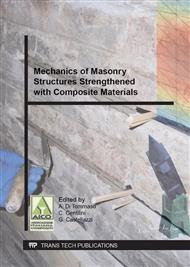[1]
Giuffrè, A.: Letture sulla meccanica delle murature storiche. Kappa, Roma (1991).
Google Scholar
[2]
Doglioni, F. et al.: Le chiese e il terremoto. LINT, Trieste, (1994).
Google Scholar
[3]
Quagliarini, E. et al.: Strengthening three-leaf masonry panel with basalt fibre ropes. First experimental data. In: Proc. 5th Int. Congr. Science and Technology for the Safeguard of Cultural Heritage in the Mediterranean Basin, Istanbul, Turkey, 22-25 November 2011, Valmar Ed., Roma, pp.276-283, (2012).
Google Scholar
[4]
Quagliarini, E. et al.: Masonry strengthening through basalt fibre ropes. Experimental and analytical results. In: Proc. 8th Int. Conf. on Structural Analysis of Historical Construction, Wroclaw, Poland, 15-17 October 2012, DWE Ed., Wroclaw, pp.1905-1913, (2012).
Google Scholar
[5]
Van de Velde, K. et al.: Basalt Fibres as Reinforcement for Composites. In: Proc. 10th Int. Conf. on Composites/Nano Engineering, University of New Orleans, New Orleans, LA, USA, (2003).
Google Scholar
[6]
Wei, B. et al.: Environmental resistance and mechanical performance of basalt and glass fibers. Materials Science and Engineering A, 527 (2010), 4708-4715.
DOI: 10.1016/j.msea.2010.04.021
Google Scholar
[7]
Sim, J. et al.: Characteristics of basalt fiber as a strengthening material for concrete structures. Composites: Part B, 36 (2005), 504-512.
DOI: 10.1016/j.compositesb.2005.02.002
Google Scholar
[8]
Papanicolaou, C. et al.: Externally bonded grids as strengthening and seismic retrofitting materials of masonry panels. Construction and Building Materials, 25 (2011), 504–514.
DOI: 10.1016/j.conbuildmat.2010.07.018
Google Scholar
[9]
Brik, V.B. Advanced concept concrete using basalt fiber composite reinforcement. Final report for Highway-IDEA Project 86 submitted to NCHRP-IDEA, (2003).
Google Scholar
[10]
Landucci, G. et al.: Design and testing of innovative materials for passive fire protection. Fire Safety Journal, 44 (2009), 1103–1109.
DOI: 10.1016/j.firesaf.2009.08.004
Google Scholar
[11]
Quagliarini, E. et al: Tensile characterization of basalt fibre rods and ropes: a first contribution. Construction and Building Materials, 34 (2012), 372-380.
DOI: 10.1016/j.conbuildmat.2012.02.080
Google Scholar
[12]
UNI EN 1015-11 Methods of test for mortar for masonry. Determination of flexural and compressive strength of hardened mortar, (2007).
DOI: 10.3403/01905442
Google Scholar
[13]
UNI EN 772-1: Methods of test for masonry units. Determination of compressive strength, (2011).
Google Scholar
[14]
Hamoush, S. et al: Out-of-plane behavior of surface-reinforced masonry walls. Construction and Building Materials, 16 (2002), 341–351.
DOI: 10.1016/s0950-0618(02)00024-7
Google Scholar
[15]
Ayman, S. M.: Out-of-plane flexural behavior of unreinforced red brick walls strengthened with FRP composites. Composites: Part B, 38 (2007), 559–574.
DOI: 10.1016/j.compositesb.2006.07.019
Google Scholar
[16]
Hamed, E. & Rabinovitch, O.: Failure characteristics of FRP-strengthened masonry walls under out-of-plane loads. Engineering Structures, 32 (2010), 2134-2145.
DOI: 10.1016/j.engstruct.2010.03.016
Google Scholar
[17]
Sandoval, C. et al.: Testing and numerical modelling of buckling failure of masonry walls. Construction and Building Materials, 25 (2011), 4394–4402.
DOI: 10.1016/j.conbuildmat.2011.01.007
Google Scholar
[18]
Varela-Rivera, J.L. et al.: Out-of-plane behavior of confined masonry walls. Engineering Structures, 33 (2011) 1734–1741.
DOI: 10.1016/j.engstruct.2011.02.012
Google Scholar
[19]
[C.R. Willis, C.R.: Out-of-plane strength of brick masonry retrofitted with horizontal NSM CFRP strips. Engineering Structures 32 (2010), 547-555.
DOI: 10.1016/j.engstruct.2009.10.015
Google Scholar
[20]
Beolchini, G. C. et al.: Repertorio dei meccanismi di danno, delle tecniche di intervento e dei relativi costi negli edifici in muratura – Definizione di modelli per l'analisi strutturale degli edifici in muratura. Vol. II – Parte 1. Convenzione di Ricerca con la Regione Marche; Consiglio Nazionale delle Ricerche – Istituto per la Tecnologia delle Costruzioni, Sede di L'Aquila; Dipartimento di Ingegneria delle Strutture, delle Acque e del Terreno (DISAT) – Università degli Studi di L'Aquila. L'Aquila, (2005).
DOI: 10.3934/dcdsb.2009.12.455
Google Scholar


